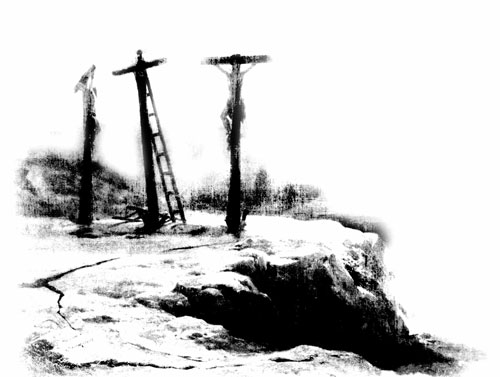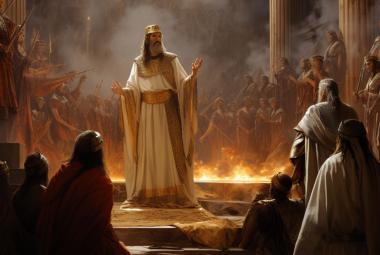We tend to use the term “The Gospel” rather loosely. However, Paul specifically defines The Gospel in 1 Corinthians 15:1-4 and includes the following essential, minimalist details:
Moreover, brethren, I declare unto you the gospel which I preached unto you, which also ye have received, and wherein ye stand; By which also ye are saved, if ye keep in memory what I preached unto you, unless ye have believed in vain. For I delivered unto you first of all that which I also received, how that Christ died for our sins according to the scriptures; And that he was buried, and that he rose again the third day according to the Scriptures:
1 Corinthians 15:4
That’s it. (What is interesting is what he didn’t include: he didn’t refer to His miracles, His teaching, or His example. It was entirely related to His death, His burial, and His resurrection. How rare it is that we ever hear about those issues from our pulpits.) When Paul alludes to “the Scriptures,” he is dealing with the Old Testament. This raises a provocative question: where in the Old Testament does it indicate that the Messiah would spend “three days” in the grave be-fore rising again?
I suggest that there are at least four references.
1) The sign of Jonah. Jesus Himself identifies this as an explicit sign in Matthew 12:40 (qv. Jonah 1:27).
2) The Akedah. If you have studied Genesis 22 care-fully, you discovered that Abraham knew that he was acting out a prophecy: that’s why he named the location “...in the mount of the Lord it shall be seen” (Gen 22:14). Isaac was “dead” to Abraham when the commandment came. He was restored to Abraham after three days.
Accounting that God was able to raise him up, even from the dead; from whence also he received him in a figure.
Hebrews 11:19
Two thousand years later, another Father would give His Son on that very spot. And He would be raised after three days right nearby. 3) The declaration of Rahab. This one is a bit more subtle. It deals with Rahab giving cover to the two spies in Joshua Chapter 2:1-24. When they get ready to depart:
Then she let them down by a cord through the window: for her house was upon the town wall, and she dwelt upon the wall.
Joshua 2:15
The word “cord” translates the Hebrew word, חֵבֶל chebel, which can mean a cord or rope; but, it also can mean “pain, sorrow, or travail.” In response to her hospitality, they, in turn, promise to protect her family:
Behold, when we come into the land, thou shalt bind this line of scarlet thread in the window which thou didst let us down by: and thou shalt bring thy father, and thy mother, and thy brethren, and all thy father’s household, home unto thee.
Joshua 2:18
In referring to the cord, or thread, they use a different word: תקוה tiqvah, which can mean cord, but it can also mean “hope, expectation, things hoped for.” (In fact, Ha Tiqvah, “The Hope,” is the National Anthem of Israel.) In between these two terms, Rahab gives them a provocative instruction:
And she said unto them, Get you to the mountain, lest the pursuers meet you; and hide yourselves there three days, until the pursuers be returned: and afterward may ye go your way.
Joshua 2:16
 Why three days? Why not two, or four, or five? Was this a deliberate specification, or did the Holy Spirit simply intervene to exploit the opportune these puns involved?
Why three days? Why not two, or four, or five? Was this a deliberate specification, or did the Holy Spirit simply intervene to exploit the opportune these puns involved?
Three days between sorrow and travail and hope and expectation; three days between Golgotha and the empty tomb. Some will shrug this off as a mere coincidence. However, “coincidence” is not a kosher word. This allusion may be a bit obscure for some, but the fourth one is a corker—from Jesus’ own words:
4) Psalm 22:6. From the cross: “I am a worm and no man…
The term “worm,” tolah, also means “scarlet” (it is rendered “crimson” 38 times).
Scarlet dye was made from a particular worm, Cermes vermilio. The Cermes vermilio pierces the thin bark of twigs to suck the sap, from which it prepares a waxy scale to protect its soft body. The red dye is in this scale. When reproducing, the female climbs a tree (usually the holm oak), where it bears its eggs; the larvae hatch and feed on the body of the worm. It literally gives its life…
A crimson spot is left on the branch; when the scarlet spot dries out, in three days, it changes to white as it flakes off…
This is summarized by Isaiah:
Come now, and let us reason together, saith the LORD: though your sins be as scarlet, they shall be as white as snow; though they be red like crimson, they shall be as wool.
Isaiah 1:18
This, too, of course, underscores the validation of our Lord’s victory on our behalf in His resurrection. But this example goes even further:
The more we study the Biblical text, the more we uncover evidence that every detail is the result of deliberate design.
These discoveries remind us that we are dealing with a supernatural work, a work beyond our imagining; a message from the edge of eternity; a work that will alter our own personal destinies.
Praise His Name. Indeed! (If you can find a fifth example, I would love to hear about it!)






